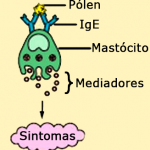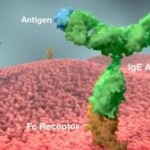What is an Allergy?
An allergy is the response of the body’s immune system to normally harmless substances, such as pollen, house dust mites, foods, medicines. Whilst in most people these substances (allergens) pose no problem, in allergic individuals their immune system identifies them as a ’threat’ and produces an inappropriate, exaggerated response.
Allergic individuals (having a genetic predisposition to atopy) produce specific levels of an antibody called IgE. The main function of this antibody is not to create allergic diseases. Its original purpose is the destruction of parasites.
However, in developed and affluent societies that have largely eradicated parasites there is a group of people with a genetic tendency to produce more IgE, and these would be the atopic population susceptible to manifesting allergic reactions.
When a patient has been sensitized (whose body has produced IgE by repeated exposure to an allergenic substance such as pollens, mites) the allergen binds to the IgE of mast cells and these explode releasing histamine and other inflammatory substances, causing the characteristic symptoms of an allergic response.
- Mast Cell with IgE
- Pollen, IgE, Mast Cell, Mediators
- IgE
How do allergic conditions originate?
We have already mentioned that there is a genetic predisposition in some people to produce more IgE, but in order to develop allergies, individuals need to be exposed to substances capable of producing an immune hypersensitivity response.
When one parent is allergic, the chance of the child having allergies is about 50% and about 70% when both parents are allergic. The substances which may cause allergy are called allergens and there are many types of them.
What is causing your allergy?
-
Particles – inhaled or airborne: dust mites, pollen, mold spores, dander, dandruff, animal excrement, feathers and workplace substances such as flour, gases, latex powder, wood, etc.
- Foods – cow’s milk, being more common in childhood, egg and fish and in adulthood fruits of the rosaceae family like peaches, nuts such as walnuts and peanuts, and seafood like shrimp.
- Drugs – can be caused by any medicine, but for an allergic reaction to occur it is necessary to be exposed several times to a causative allergen, usually occurring with the most widely used drugs, such as anti-inflammatory drugs (although anti- inflammatories typically occur by a different mechanism, cyclooxygenase inhibitors) and with antibiotics – the ones derived from penicillin derivatives. Other groups of drugs are usually anesthetics and those used in chemotherapy.
- Hymenoptera venoms – mainly from wasp and bee stings.
- Contact dermatitis – caused by substances such as metals (nickel), perfumes, dyes, cosmetics, polishes, etc.
- Latex – sensitization may be caused in different ways – inhaled, by contact or from cross-reaction with foods that are similar in some protein to latex.
Allergology is the medical specialty concerned with allergic conditions, their diagnosis, avoidance measures and treatment.
Click on the image to download Global Atlas of Allergy.pdf (26 Mb.)
 Print this page
Print this page







